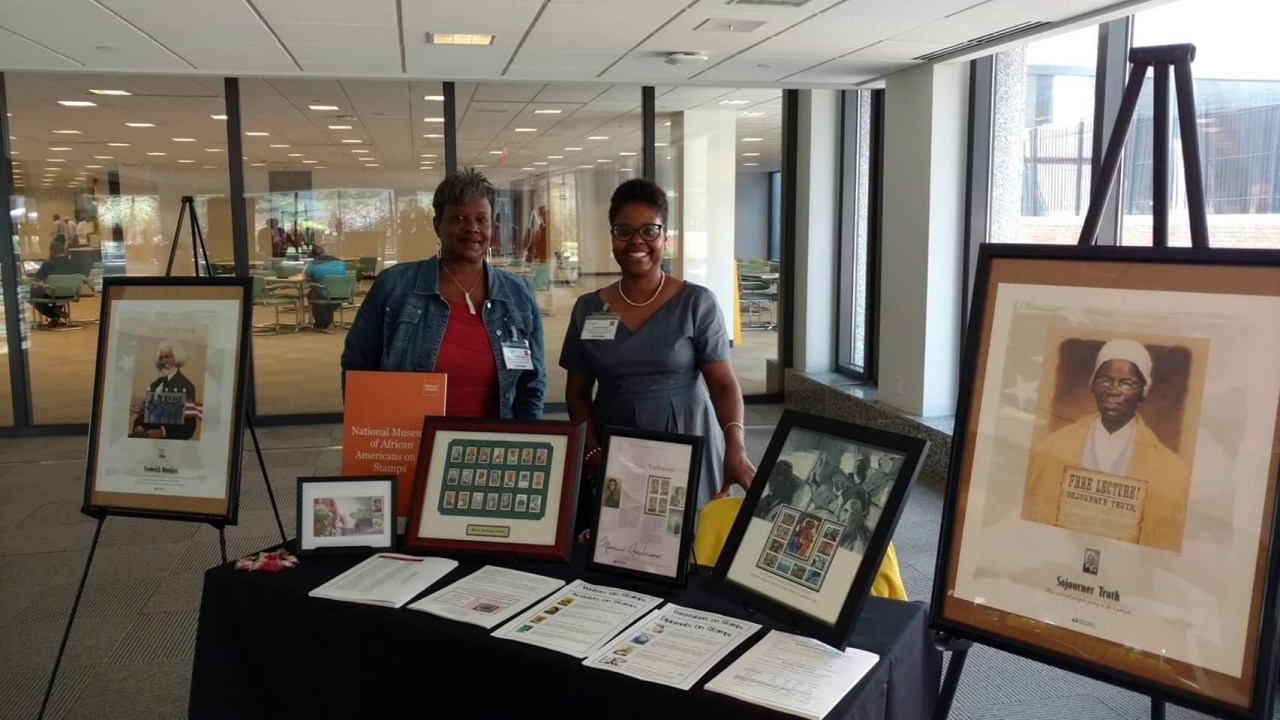
It was such an honor to attend the 40th Association of African American Museums (AAAM) conference. To be surrounded by people that are so passionate and committed to keeping the legacies and histories of African Americans alive and well was so inspiring. As a newbie, I had an opportunity to attend some very informative sessions and just listen to the wealth of knowledge that has been attained through trial and error over the years. I found the new developments in digital and traveling museums very interesting. In my case, I felt validated that having a “Pop-up” exhibit where 75 people visit is just as necessary as institutions that have a physical space but may have very few visitors all month. Finding new ways to reach a broader audience is necessary for survival.
Even before I turned my hobby of collecting African Americans on stamps into a nonprofit organization last year, I had been sharing my passion for learning and sharing black history using stamps on social media for over five years. I was doing themed displays at various events and competing in single-frame philatelic competitions. This got me the status of “nerd” and the handle of being “The Stampkeeper” along with a few bronze ribbons.
Below are just a few of the interesting things I learned that other African American and civil rights museums are doing in the realm of traveling and digital display:
- There are over 40,000 artifacts at the National Museum of African American History and Culture (NMAAHC) but only about 4,000 items can be displayed at any given time. The virtual tour they hosted for the first time last year during Juneteenth 2017 was a giant step to sharing more of the collection and gave their supporters more of a reason to continue to donate historical items and funds. More information about this event can be found at National Museum of African American History and Culture Hosts First Interactive Virtual Tour. The success in that space could only contribute to the new media exhibits being developed by them and other museums.
- Another of NMAAHC’s recent partnerships is with Google which has taken the virtual to another level by bringing rare artifacts to life with 3D.
- The Jim Crow Museum of Racist Memorabilia has also tapped into something great. Their Jim Crow Virtual Tour is excellent and is truly a model to be followed. Their website states, “The staff of the Jim Crow Museum is excited to share with the public a virtual tour of the facility. This tour gives our virtual visitors an opportunity to learn about the museum.” With this controversial topic, a visitor has time to process the reality of history. They give credit to Real Space of Grand Rapids who created the tool. As a stamp collector for over 27 years, having this tool could greatly enhance my themed exhibits and reduce the amount of handling of the philatelic materials.
- Another example of advancement is the Withers Collection Museum. It has utilized technology to digitize the photographs of Dr. Ernest C. Withers (1922-2007). Dr. Withers is most noted for photographs of key civil rights events like the Montgomery Bus Boycott and the strike of Memphis sanitation workers. These priceless photos must be preserved and his daughter, Rosalind Withers, has put the mechanisms in place to do it. Digitization is considered the solution to providing audiences with access to diverse media and material in museum collections.
- In the traveling museum space, I am following the Black History 101 Mobile Museum. They seem to have found their niche and a following that values the artifacts and knowledge that they share. Known as the Schomburg of the hip-hop generation, Khalid el-Hakim has an award-winning collection of over 7,000 original artifacts of Black Memorabilia dating from the trans-Atlantic slave trade era to hip-hop culture. They travel throughout the country and present at schools, conferences, libraries, museums, and cultural events to name a few venues. This is how I have been expanding my visibility as well.
Anyone with a website can claim the title of being a virtual museum. How we position the programming to entice or convince our visitors to enjoy the fruits of our labor takes on a new perspective when they may never have the opportunity to visit a brick and mortar space but want to experience the euphoric feelings obtained only by appreciating a collection of artifacts preserved by a passionate group of people who see the value in community learning, conversations and caring by any means necessary.
Charlene “The Stampkeeper” Blair, is the Founding Director of the travelling National Museum of African Americans on Stamps. She is the IL Chapter Director for the Ebony Society of Philatelic Events and Reflections (ESPER) and member of the Association of African American Museums (AAAM). Charlene is an award-winning stamp exhibitor and is committed to sharing black history through the hobby of stamp collecting and the possibilities of being a museum professional with a new generation.








